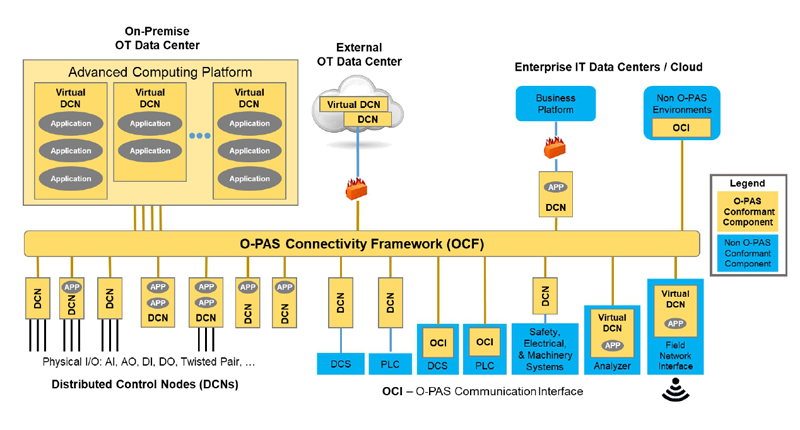Open Process Automation (O-PAS)

Open Process Automation is a new concept for process automation that, thanks to open standards, should enable extensive digitization. The aim is to create an open platform, analogous to what is customary in the IT sector, where all possible applications can be deployed in a flexible and scalable way and can exchange data.
Open Process Automation was created in 2016 from an initiative by ExxonMobil to create an alternative to the rather closed DCS systems that are used today to run plants in the process industry. The starting point was to create an open platform where users would no longer be tied to a supplier of a DCS system and where data could be accessed more easily to simplify the implementation of new digitalisation applications.
In recent years, around a hundred companies from the process industry and their suppliers have joined the initiative. Management of the Open-Process Automation Standard (O-PAS), as it is now called, has since been transferred to the Open Process Automation Forum (OPAF), a working group in The Open Group, which coordinates several standardization initiatives.
Three building blocks
The concept for Open Process Automation defines three crucial elements that have to work together on the basis of open standards in a transparent, flexible and above all supplier-independent way. The concept is intended to be scalable and to be easy to adapt and expand when new applications require it.
Connectivity Framework
The central element in this is the O-PAS Connectivity Framework, which can be seen as the backbone network over which all communication between intelligent systems in a plant takes place. In practice, this can be a combination of several networks - for example, a classic Ethernet network in combination with a real-time network (TSN). The communication protocol will be OPC UA.
Distributed Control Nodes (DCN)
The intelligent participants in that Connectivity Framework are referred to in the O-PAS concept as Distributed Control Nodes (DCN). Initially, this included intelligent instruments and I/O modules that aggregate the data from underlying sensors. Gradually, however, the concept of DCNs was opened up to all participants in the network. After all, a PLC that controls a packaging machine can on a higher level also be regarded as a supplier and consumer of data. The next step was to conceive of applications as DCNs - albeit virtual ones. A software for Advanced Process Control, for example, uses data from the Framework and in turn supplies the network with the setpoints for other DCNs. In this way, every participant in the network has become a DCN. The aim is to establish in an unambiguous manner how their access can be controlled and how they must provide data.
Advanced Computing Platform
The third building block in Open Process Automation is the Advanced Computing Platform, which refers to a scalable IT infrastructure in which all possible applications in a plant can run. It can be one or more servers with an open operating system that makes it possible, via virtualization, to create all kinds of environments in which all possible applications can run, from existing software such as that of the current DCS systems to modern cloud-based apps.
© Productivity.be
Feel free to share
Calendar
23/09 - 25/09: Electronics & Applications, Jaarbeurs Utrecht (Nl)
07/10 - 09/10: Motek, Stuttgart (D)
08/10 - 15/10: K, Düsseldorf (D)
10/03/26 - 13/03/26: TechniShow, Jaarbeurs Utrecht
20/04/26 - 24/04/26: Hannover Messe, Hannover (D)
